
Date: 2024-10-19 Page is: DBtxt003.php txt00026356
TPB EXPERIENTIAL LEARNING
Electro-Voice (EV)
--- // ---
EV At 90
Powering The Passion Of Performance
For Nine Decades (And Counting)
Electro-Voice (EV)
--- // ---
EV At 90
Powering The Passion Of Performance
For Nine Decades (And Counting)
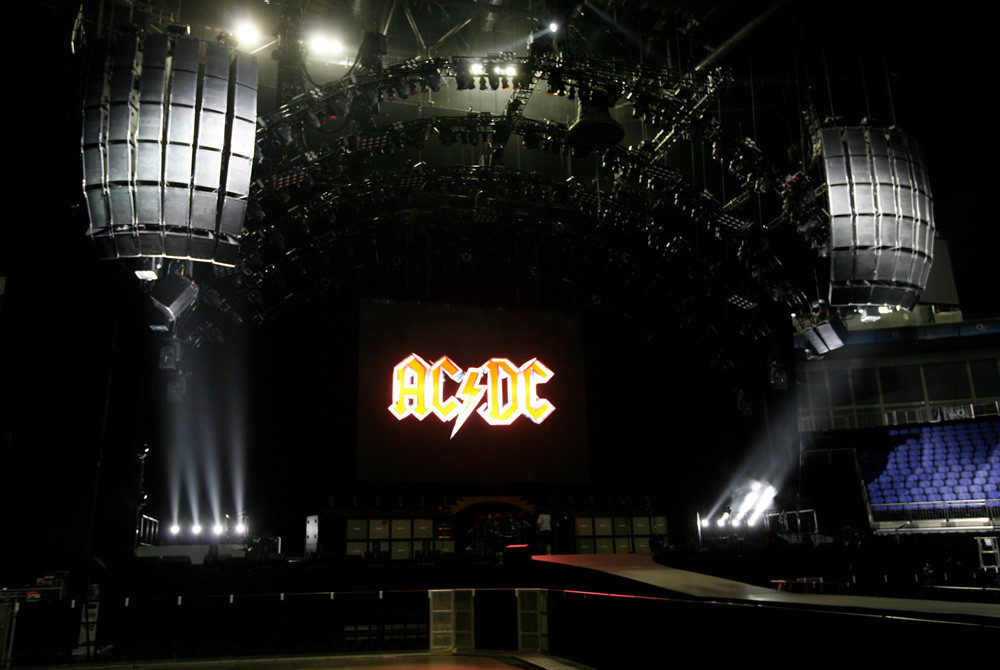
Original article: PART 1
Original article: PART 2
Original article: PART 3
Go here for more on the history of EV, including an in-depth timeline spanning the company’s 90 years. TO FIX
Peter Burgess COMMENTARY
I was employed by Gulton Industries from 1970 to 1974. EV ... ElectroVoice was a Gulton subsidiary during this time.
I had been recruited by Gulton in the positions of 'Budget Manager'.
At the time I had a reputation for being a 'hard nose' corporate performance analyst with a considerable track record for impressive profit improvement accomplishment even though I was only 30 years old!
Gulton had acquired about 40 subsiduiaries during the early to mid-60s while it was generating massive positive cash flows as a result of its leadership role in the technology of the time.
However by the end of the 1960s Gulton was seriously over-extended with all its subsidiaries needing investment to be successful. When I joined the company in early 1970, it was almost out of cash and credit. My initial budget analysis suggested that the company would be 'out of business' in less than three months unless meaningful cost cuts were made immediately.
Worse, the economy of the 1970s was not going to be like the 1960s. It was part of my 'job description' to figure out how to make amends for the huge erros the company had made in the 1960s.
My immediate 'boss' was an impressive manager by the name of Jim Gladstone. He hired me ... and a few years later he fired me because what we had tried to do was essentially impossible!
I bear Jim Gladstone no ill-will at all. He and I did our best to make Gulton a better company ... and while we had some considerable success, it was not enough.
In the role of 'budget manaager' I had to review and 'approve' the budget of ElectoVoice. At some level EV was clearly a very competent company. I recall getting the EV management to end their efforts to 'outsource' low end audio systems production to South Korea because my analysis showed they were unprofitable. As I recall for 2 Christman seasons in a row the Korean made consumer electonics products needed for Christmas demand arrived in the stores in January rather than November/December.
I was impressed with ElectroVoice and am proud to have been assoicated in a modest way with its ongoing success.
There is one other link that I have with EV.
After my work as 'budget manager' with Gulton I was assigned to serve as the 'VP and Controller' of 'Southern States Inc. (SS), another subsidiary of Gulton in Hampton, Georgia. This subsidiary needed significant management analysis and strategic redirection. I knew about the financial performance of SS and the behavior of its senior staff relative to 'gaming' the financial reporting. For two years in a row monthly reports showed profits for 11 months and then after annual audit adjustments the final accounts for the year showed a loss. As budget manager doing head office consolidation I had made provision for these huge annual end of year adjustments, but the local SS management got it wrong not once but multiple times.
See more about my work at Southern States (SS) at this link
I include reference to Southern States here because Roger Gaines who was an impressive player within my work at SS went on to a senior role in the management at ElectroVoice (EV) in Buchanan, Michigan
Roger and I lost touch decades ago after I moved from Georgia back to New Jersey and New York. I was always impressed by his competence and his values, and would not be at all surprised to find that he made an important contribution to EV's success over the years.
Peter Burgess
END OF INTRODUCTION

Powering The Passion Of Performance
For Nine Decades (And Counting)
EV At 90: PART 1
September 5, 2017
A look at the history of one of the most storied brands in professional audio, as well as where the company is going today and what's planned for the future.
The year was 1927, and the global professional audio industry didn’t exist. But things were about to change.
It was the year that Al Kahn and Lou Burroughs established a fledgling enterprise they called Radio Engineers in the basement of the Century Tire and Rubber Company in South Bend, Indiana. At first, they focused on servicing radios and shortly after, the retailing of radio equipment. The invested capital was $30 and a second-hand car.
Fate soon intervened, however, and at first glance, cruelly. The Great Depression, which began in 1929, all but wiped out the aspiring business. “We found ourselves insolvent to the extent of $5,000,” Kahn noted in a company history written in the early 1950s. “To survive and pay our creditors, we began work in the audio field and liquidated the remnants of the service and retail business.”
The change of direction set the young entrepreneurs on a path of technological innovation in establishing a firm that became and remains one of the bedrocks of what we now most commonly call pro audio. The first significant milestone came during the early months of 1930, when Knute Rockne, the legendary football coach at the nearby University of Notre Dame, wanted to supervise activities on all four of the team’s practice fields from a centrally located tower.

PSW Staff
Kahn and Burroughs were asked to design a public address system for the tower, and they formulated a four-loudspeaker system with a microphone and switching mechanism by which Rockne could bark training orders to each of the four squads. Rockne referred to the system as his “electric voice” and is credited with inspiring the name for the new company.
Incorporated on July 1, 1930, Electro-Voice was involved heavily in the rental and installation of public address systems for churches and other public spaces. Politicians especially had become aware of the power of the microphone to increase their reach and demanded ever more powerful PA systems. Microphones were originally manufactured only for EV’s own use, but within a few years the balance had shifted and manufacturing mics for sale to others had become the more important part of the business.
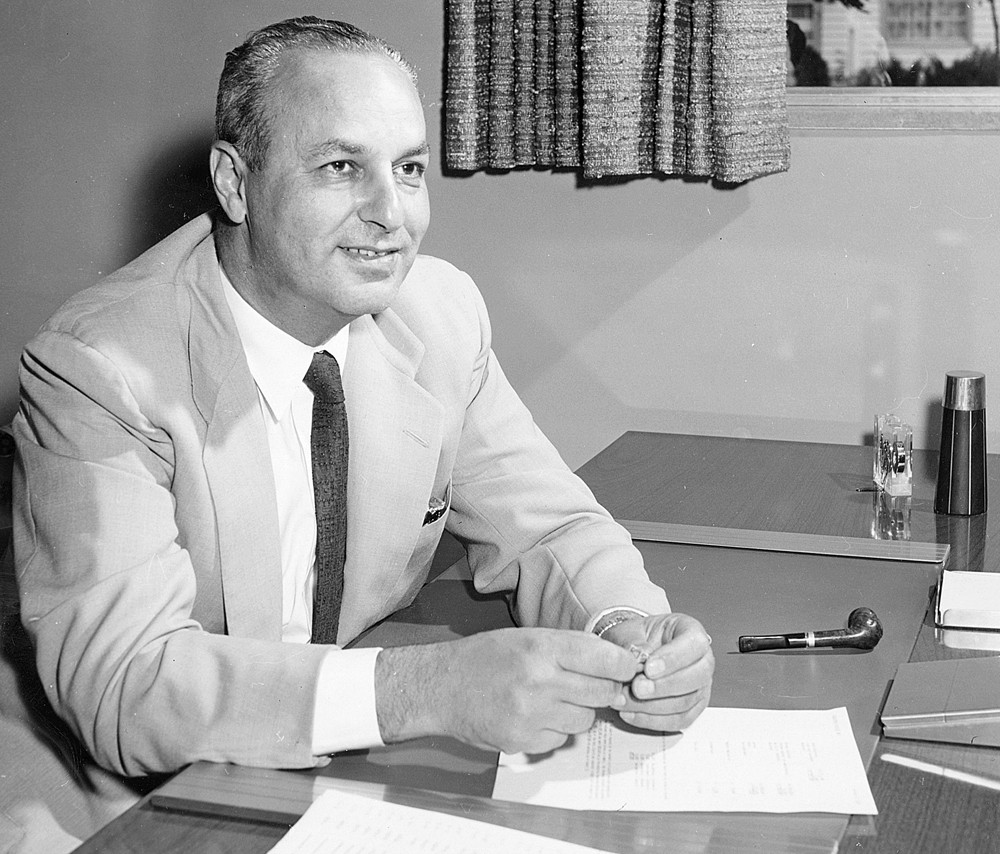
Al Kahn at his desk in the early 1950s.
Nearly nine decades later, microphones remain a staple, joined by class-leading loudspeakers and electronics, all of them further bolstered by the support of parent company Bosch GmbH, which acquired EV in 2006. It’s a serendipitous association, where as a member of the Bosch Security Systems division, EV benefits from Bosch’s own tradition and support of engineering-based solutions and leadership in a diverse range of global markets.
The result is a portfolio of options across every pro audio market while also encompassing a bigger picture by teaming with other divisions in the group, including Dynacord (electronics), RTS (intercoms), Telex (radio communications and wireless systems), and Bosch (video and security).
The vision that’s become a reality is an organization providing specialized technologies that work together seamlessly, most recently emphasized by OMNEO, an evolutionary platform for connecting devices over IP to exchange information, including control and audio content, facilitating, for example, commercial ceiling loudspeakers, security cameras, access panels, and ROIP/VOIP dispatch communications all working together seamlessly.
Problems & Solutions
The scope and scale of the EV portfolio today encompasses everything from commercial to concert sound, with products available for any application and budget. The overriding focus from the very beginning has been sonic quality, accompanied by other developments, many of them patented, that solve additional challenges.
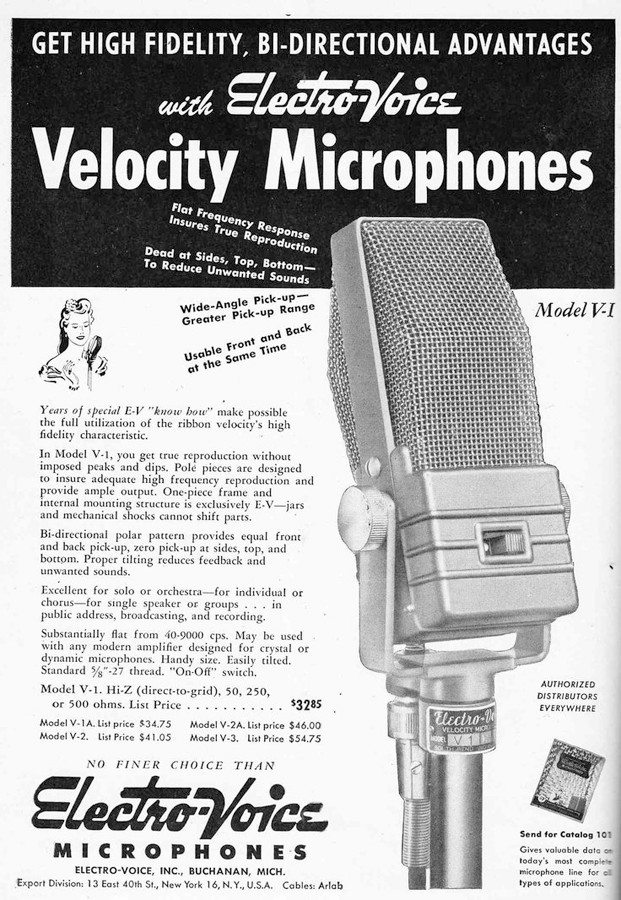
An advertisement for the EV V-1 Velocity microphone,
first to be equipped with a humbucking coil.
For example, in 1934, while going through some old technical journals, Kahn came across what he called “an ancient watt meter – patented in 1892 or thereabouts” which had a balanced winding to cancel hum from the stray 60 Hz fields that the watt meter might pick up. As he described it, “A little light bulb went off above my head, and I rushed back… got some tin snips, cut some laminations out, and I made a transformer and put it in and it worked!”
Thus the humbucking coil was born, eliminating a major problem for microphone users. The breakthrough was applied in the V-1 Velocity microphone, and according to an early EV catalog, it could “be used within 18 inches of a power supply or within two inches of an AC line. No other velocity mic in its price field has this feature at the present time.” Kahn and Burroughs followed up the next year by developing a method for stretching dynamic mic diaphragms before assembly. The manufacturing economies that resulted caused a dramatic drop in mic prices, providing another advantage for users.
Within a few years, the company had created several handheld dynamic mic designs. An example is the Model 600, described in EV product literature as offering “blast-proof high fidelity, close talking… ideal for sports announcing, mobile PA, aircraft, police and general PA and communication work.”
Business grew steadily while Kahn and Burroughs spent much of their time traveling – “converting people to our marvelous microphones throughout the country,” according to Kahn.
This growing success continued through the years of World War II, including the development of a mic using a 180-degree phase shift to cancel background noise and engineered to be attached to the helmet and rest on the lips.
Dubbed the T-45, it raised the success rate of battlefield communications from 20 percent to at least 90 percent, saving countless lives in the process.
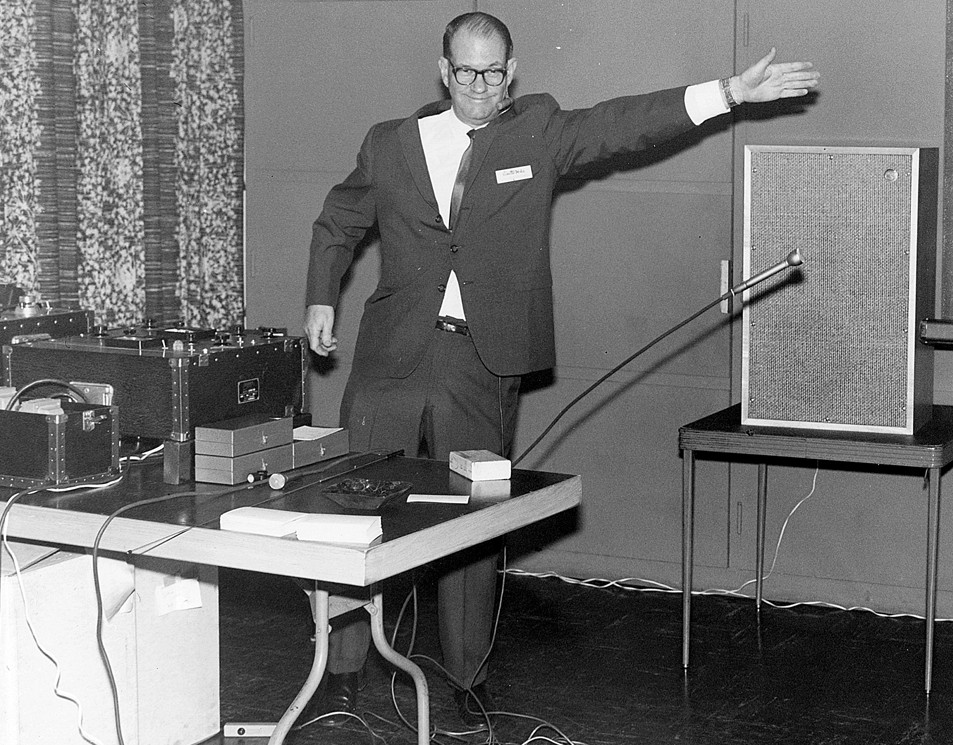
Lou Burroughs giving one of his memorably mic
presentations, this one with an EV 635a.
After the war, the rapidly growing operation transferred to Buchanan, MI, where it remained for almost 60 years over the course of several expansions.
The facility included one of the first anechoic chambers outside of a research laboratory, and eventually, the company also occupied a dedicated 28,000-square-foot research and development building in downtown Buchanan.
Another interesting note is the role EV microphones played in the rapid advancement of space flight from the late 1950s into the 1970s, beginning with early Mercury and Gemini missions through the Skylab space station. In fact, both mics and loudspeakers served Skylab during its six-year orbit, performing without failure despite a lost heat shield.
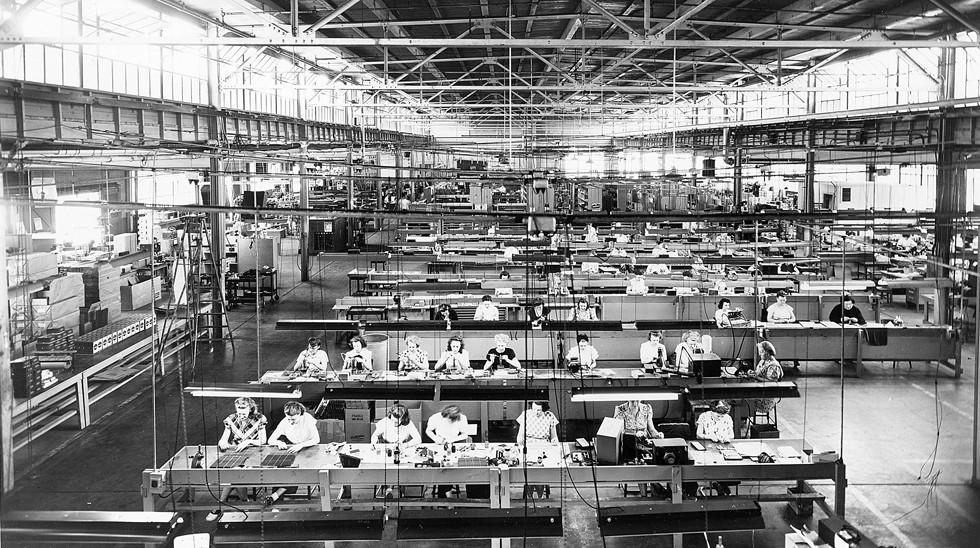
The company’s main production facilities in
Buchanan, MI in the late 1940s.
New Directions
EV also ventured into the consumer side of audio in the 1950s, beginning with a line of phonograph (record player) cartridges followed by hi-fi loudspeakers, becoming one of the largest suppliers in the U.S. But the primary focus remained on the pro market, exemplified by the introduction of Variable-D microphone technology, which reduces proximity effect. It’s at the heart of many RE Series microphones still in circulation to this day, most prominently in broadcast applications, highlighted by the venerable RE20 and most recently, the RE320.
With a patent count that topped 160 by 1980, the company continued to push in a number of beneficial directions. In the early 1970s, EV pioneered the use of holographic interferometry (laser technology) to study the motion of mic diaphragms. Initial efforts were done in partnership with the University of Michigan, and later the process was brought completely in-house.
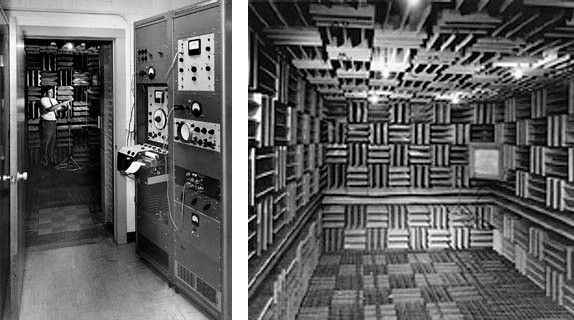
One of the first anechoic chambers outside of a research
laboratory in the Buchanan engineering department.
While EV was also known for its commercial loudspeakers, by the early 1970s serious attention was paid to furthering true professional loudspeaker technology.
The company embarked on an aggressive program of compression and driver development, both for its own loudspeaker systems as well as for third-party systems.
Simultaneously, this period saw the development of constant directivity (CD) horn technology, which dramatically improved high-frequency performance and control. The innovative horns were also light in weight, which came in handy when they were specified by noted consultant Bob Coffeen as the key components in the sound reinforcement system serving the new Silverdome in Pontiac, MI, a huge indoor sports stadium with an air-supported roof, so the light weight of the horns was a necessity.
Around the same time in the mid-1970s, Dave Klepper and Larry King of Klepper Marshall King specified CD horns for the 1976 Yankee Stadium renovation project. “We sold them our ‘line array’ – heard that term before? – made up of a huge stack of HR horns mounted in a steel structure above the outfield,” recalled Jim Long, who worked with EV for more than 40 years and remains affiliated to this day. “There was also a whole bunch of our CDP commercial horns to cover shadowed regions of the main grandstand.”
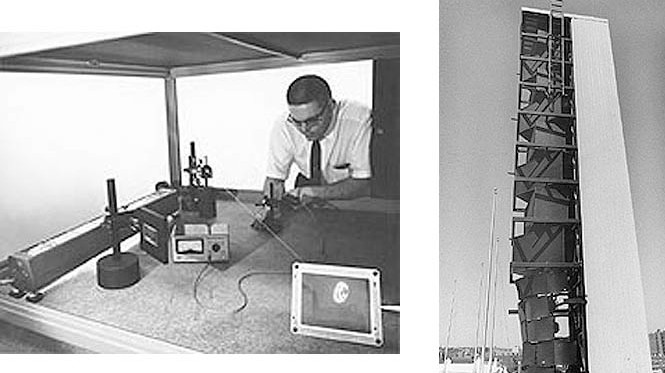
Pioneering the use laser technology to study the motion of mic diaphragms;
and at right, the stack of HR horns at Yankee Stadium.
“The dealer couldn’t equalize the system, didn’t know enough about tuning, didn’t have a spectrum analyzer, had never seen a third-octave graphic EQ, which were still kind of new then,” he continued. “So I, along with some EV technical folks, came out and worked with Larry King on tuning. I don’t even know for sure that we knew exactly what we were doing, but that system was there for a long, long time.”
END OF PART 1

Powering The Passion Of Performance
For Nine Decades (And Counting)
EV At 90: PART 2
Extreme Innovation
Developments were happening across many product categories by the mid-1970s, when EV introduced the 100S Entertainer, a compact, full-range PA with molded plastic cabinets that proved immensely popular, helping to set the pace for the huge portable loudspeaker market.
Shortly after, EV acquired TAPCO, a company founded by Greg Mackie and specializing in the development of innovative electronic products, mixers in particular. TAPCO products became a mainstay of the EV line, both individually and within packaged portable PA systems.
In fact, an EV/TAPCO 100M powered mixer could be found at the heart of every Entertainer system, while a steady stream of power amplifiers and signal processors also flowed from this well.
Eventually, the entire electronics development and manufacturing operations were merged fully under the EV umbrella.
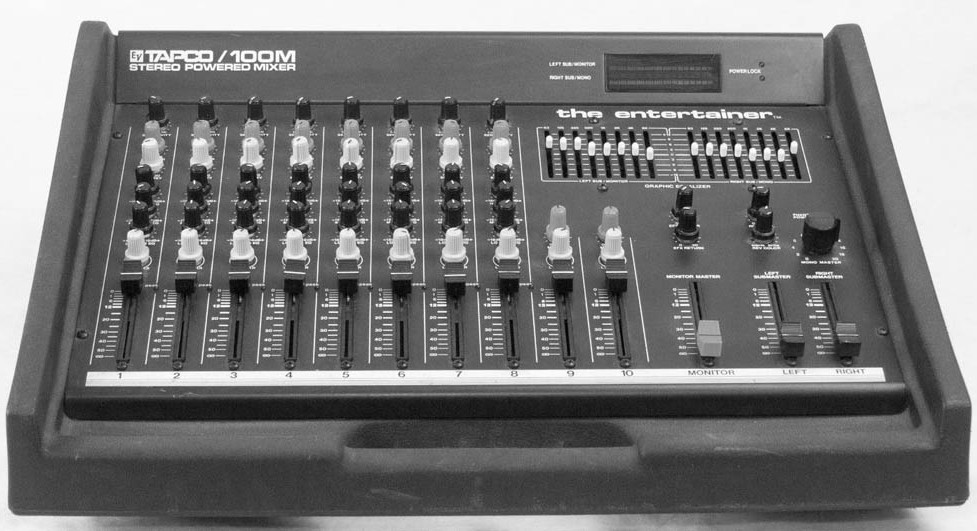
An EV/TAPCO 100M powered mixer, a ubiquitous site at gigs starting in the 1970s.
One of the many examples of where this strategy paid off significantly proved to be DeltaMax, a line of 2-way, biamped loudspeakers with companion controllers that were engineered for higher end portable and installed applications. The controllers helped further optimization in providing precision crossover, time delay and equalization, in addition to unique loudspeaker protection circuitry.
Within this same timeframe, EV unveiled a neodymium-based magnet structure for microphones, resulting in extended frequency response and increased power output. The initial N/DYM Series microphones quickly found their way on to hundreds of concert tours and stages, with the concept duplicated by other manufacturers. The breakthrough also found its way into compression and cone drivers in short order.
Shortly after, EV unveiled what is still considered to be one of the most fascinating (and effective) large-scale loudspeaker system developments to ever hit the concert touring market: Manifold Technology. As the name implies, the heart of the design utilizes a patented manifold to combine the outputs of multiple compression drivers to generate very high SPL with low distortion. It was first introduced in the MT-4, a true 4-way system split between two enclosures, with four drivers summed in each bandpass for a total of 16 drivers.
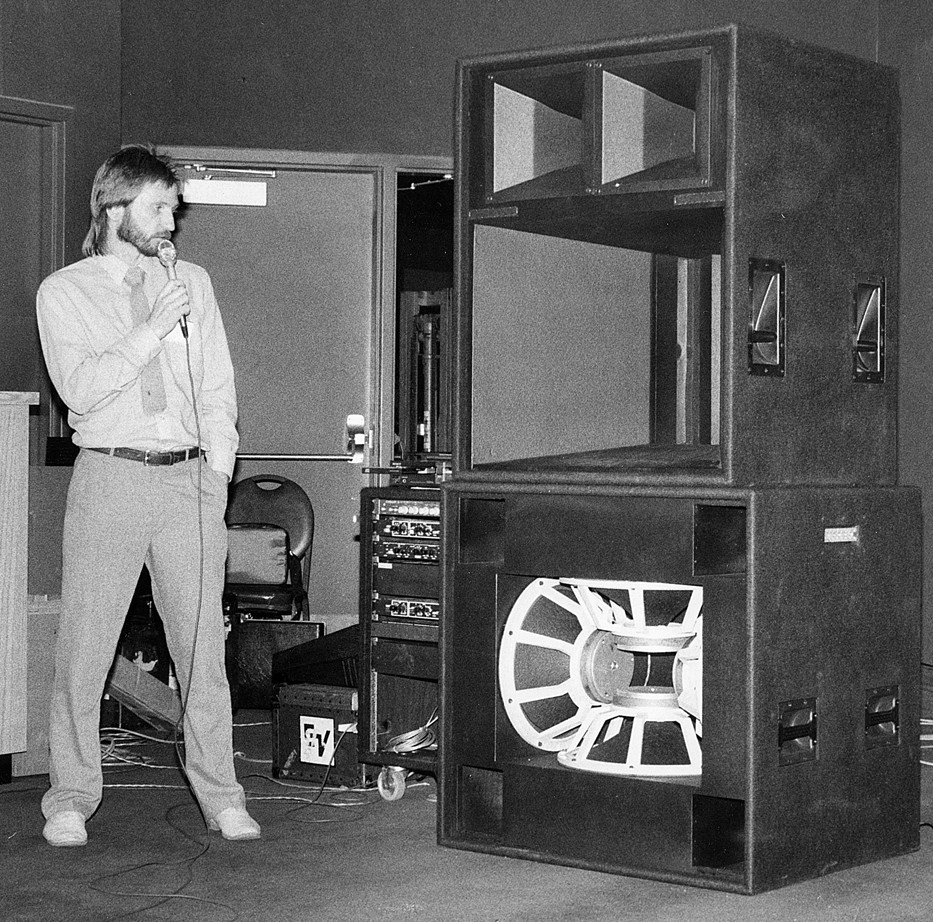
Loudspeaker design engineer Dave Carlson introducing the MT-4
concert system. Carlson has played a vital role in the development of
many of the company’s loudspeakers and now serves as chief engineer.
MT systems were a hit with touring companies and could be found on the road supporting top artists such as Aerosmith and ZZ Top. The design was soon adapted with the MT-2, offering the technology in a more compact footprint that proved popular with regional sound providers. Another variation flourished in the MH Series of horns for large-scale fixed installations.
This was followed by X-Array, developed to deliver extremely high acoustic output from lighter enclosures that were easy to array. The individual drivers, horns, cabinets, rigging and system configurations were formulated from the ground up, as was a new technology dubbed Ring-Mode Decoupling (RMD) that significantly improved clarity and intelligibility by reducing both linear and nonlinear resonance modes that “color” the output. AC/DC preferred X-Array to the extent that it was the iconic hard rock/blues band’s touring system of choice for 20 years, just recently retired.
And as line arrays became a staple of larger pro audio applications, EV answered with X-Line, offering users a choice of formats ranging from very large to compact. It too received widespread acclaim, deployed at global events like center stage in London’s Hyde Park for the Live 8 concerts, driven with EV P3000RL remote-control DSP amplifiers run with EV IRIS software, and on concert tours such as annual outings by country superstar Kenny Chesney.
The design also proved to suit the installation market, with an X-Line-based sound reinforcement system deployed at AT&T Stadium, home of the Dallas Cowboys of the National Football League and site of numerous special events.
Developments were happening across many product categories by the mid-1970s, when EV introduced the 100S Entertainer, a compact, full-range PA with molded plastic cabinets that proved immensely popular, helping to set the pace for the huge portable loudspeaker market.
Shortly after, EV acquired TAPCO, a company founded by Greg Mackie and specializing in the development of innovative electronic products, mixers in particular. TAPCO products became a mainstay of the EV line, both individually and within packaged portable PA systems.
In fact, an EV/TAPCO 100M powered mixer could be found at the heart of every Entertainer system, while a steady stream of power amplifiers and signal processors also flowed from this well.
Eventually, the entire electronics development and manufacturing operations were merged fully under the EV umbrella.
One of the many examples of where this strategy paid off significantly proved to be DeltaMax, a line of 2-way, biamped loudspeakers with companion controllers that were engineered for higher end portable and installed applications. The controllers helped further optimization in providing precision crossover, time delay and equalization, in addition to unique loudspeaker protection circuitry.
Within this same timeframe, EV unveiled a neodymium-based magnet structure for microphones, resulting in extended frequency response and increased power output. The initial N/DYM Series microphones quickly found their way on to hundreds of concert tours and stages, with the concept duplicated by other manufacturers. The breakthrough also found its way into compression and cone drivers in short order.
Shortly after, EV unveiled what is still considered to be one of the most fascinating (and effective) large-scale loudspeaker system developments to ever hit the concert touring market: Manifold Technology. As the name implies, the heart of the design utilizes a patented manifold to combine the outputs of multiple compression drivers to generate very high SPL with low distortion. It was first introduced in the MT-4, a true 4-way system split between two enclosures, with four drivers summed in each bandpass for a total of 16 drivers.
While EV was also known for its commercial loudspeakers, by the early 1970s serious attention was paid to furthering true professional loudspeaker technology.
The company embarked on an aggressive program of compression and driver development, both for its own loudspeaker systems as well as for third-party systems.
Simultaneously, this period saw the development of constant directivity (CD) horn technology, which dramatically improved high-frequency performance and control. The innovative horns were also light in weight, which came in handy when they were specified by noted consultant Bob Coffeen as the key components in the sound reinforcement system serving the new Silverdome in Pontiac, MI, a huge indoor sports stadium with an air-supported roof, so the light weight of the horns was a necessity.
Around the same time in the mid-1970s, Dave Klepper and Larry King of Klepper Marshall King specified CD horns for the 1976 Yankee Stadium renovation project. “We sold them our ‘line array’ – heard that term before? – made up of a huge stack of HR horns mounted in a steel structure above the outfield,” recalled Jim Long, who worked with EV for more than 40 years and remains affiliated to this day. “There was also a whole bunch of our CDP commercial horns to cover shadowed regions of the main grandstand.”
“The dealer couldn’t equalize the system, didn’t know enough about tuning, didn’t have a spectrum analyzer, had never seen a third-octave graphic EQ, which were still kind of new then,” he continued. “So I, along with some EV technical folks, came out and worked with Larry King on tuning. I don’t even know for sure that we knew exactly what we were doing, but that system was there for a long, long time.”
END OF PART 2

Powering The Passion Of Performance
For Nine Decades (And Counting)
EV At 90: PART 3
September 5, 2017
EV was acquired by Gulton Industries in the mid-1960s, and experienced a few more mergers and acquisitions over the decades. The brand is now headquartered with parent company Bosch in Burnsville, MN, just outside of Minneapolis, in modern facilities that include state-of-the-art engineering and design facilities, including numerous test labs and – of course – a large-scale anechoic chamber.
The company is staffed by a team comprised of veterans that collectively have more than a century of audio expertise now leading a younger wave of well-trained professionals who are being schooled in the “EV way.” It’s a philosophy rooted not just in the product and tech side, but also in providing solutions to customers, going all the way back to young Al Kahn and Lou Burroughs traveling the country to educate and inform.
The synergy with Bosch – now into its second decade – has resulted in the enhancement of core strengths and competencies with the brands and the considerable strengths of a truly global organization and its deep resources.
An example of this synergy is the EV-Innovation family of installation-dedicated loudspeakers that launched in 2009, the largest ongoing loudspeaker development program in company history that continues to expand. The deep line of sonically matched systems spans multiple categories from very compact to large-scale, available in a wide range of coverage patterns and designs that include array, front-loaded and horn-loaded formats.
One of the many examples of where this strategy paid off significantly proved to be DeltaMax, a line of 2-way, biamped loudspeakers with companion controllers that were engineered for higher end portable and installed applications. The controllers helped further optimization in providing precision crossover, time delay and equalization, in addition to unique loudspeaker protection circuitry.
Within this same timeframe, EV unveiled a neodymium-based magnet structure for microphones, resulting in extended frequency response and increased power output. The initial N/DYM Series microphones quickly found their way on to hundreds of concert tours and stages, with the concept duplicated by other manufacturers. The breakthrough also found its way into compression and cone drivers in short order.
Shortly after, EV unveiled what is still considered to be one of the most fascinating (and effective) large-scale loudspeaker system developments to ever hit the concert touring market: Manifold Technology. As the name implies, the heart of the design utilizes a patented manifold to combine the outputs of multiple compression drivers to generate very high SPL with low distortion. It was first introduced in the MT-4, a true 4-way system split between two enclosures, with four drivers summed in each bandpass for a total of 16 drivers.
MT systems were a hit with touring companies and could be found on the road supporting top artists such as Aerosmith and ZZ Top. The design was soon adapted with the MT-2, offering the technology in a more compact footprint that proved popular with regional sound providers. Another variation flourished in the MH Series of horns for large-scale fixed installations.
This was followed by X-Array, developed to deliver extremely high acoustic output from lighter enclosures that were easy to array. The individual drivers, horns, cabinets, rigging and system configurations were formulated from the ground up, as was a new technology dubbed Ring-Mode Decoupling (RMD) that significantly improved clarity and intelligibility by reducing both linear and nonlinear resonance modes that “color” the output. AC/DC preferred X-Array to the extent that it was the iconic hard rock/blues band’s touring system of choice for 20 years, just recently retired.
The design also proved to suit the installation market, with an X-Line-based sound reinforcement system deployed at AT&T Stadium, home of the Dallas Cowboys of the National Football League and site of numerous special events.
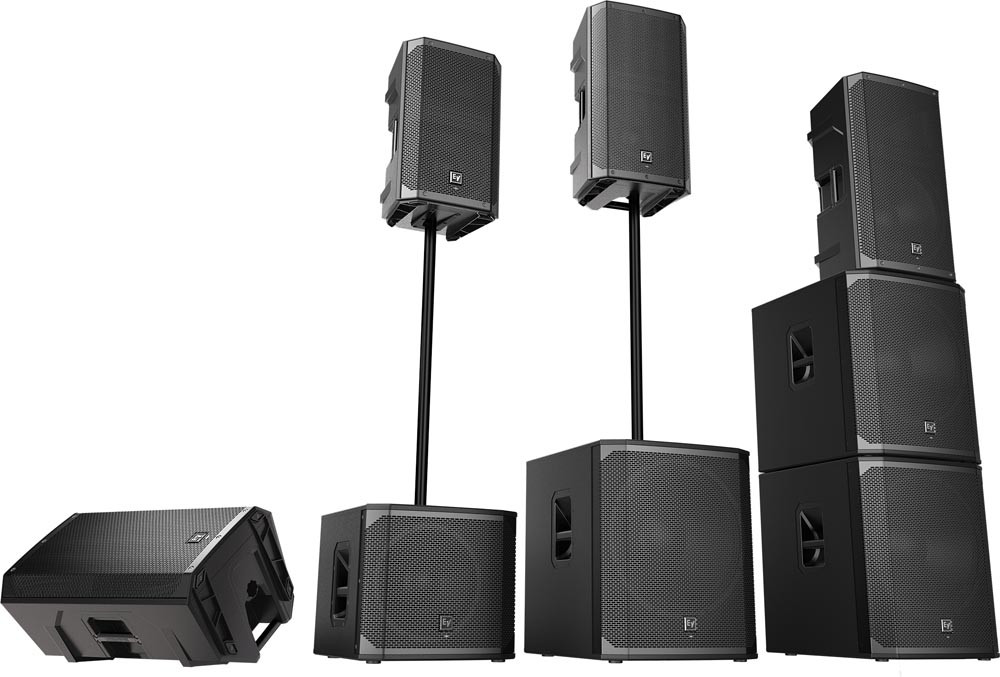
The new EXL200 line of portable powered loudspeakers.
Several years ago considerable focus went into bolstering a leadership position in the portable powered loudspeaker market, producing a successful result in relatively short order. The ZLX Series of powered/DSP models housed in compact, lightweight poly enclosures, are among the best selling portable boxes in the world. The line is deep and continues to get deeper, as evidenced by the just-announced EXL200 that combines EV components with things like versatile gain, mixing and processing.
Where It’s At
Microphones development continues apace, as evidenced by last year’s launch of the ND Series of wired vocal and instrument mics that incorporate the company’s latest developments in neodymium technology, and with features unique to both specific applications and budgets. At the heart of the new dynamic models is a new large-diaphragm capsule design that takes the technology of the original N/DYM capsules to a new level of sonic performance.

Noted vocalist Glenda Rolle performing with a new ND Series mic.
On the electronics front, the aforementioned P Series of amplifiers continued to grow and evolve over more than a decade, with thousands of units still performing faithfully around the world. A significant step forward is the recent launch of two new dual-channel power amplifier series from EV’s Germany-based sibling brand Dynacord: the L Series (for live/portable) and the C Series (for installations).
Optimized for use with EV loudspeakers, they have a linear design with feature sets that bring professional performance to a more accessible price point, with an easy-to-use software tool facilitating full configuration, control, and supervision of sound systems with multiple amplifiers. Both series consist of four dual-channel models, each with different output power specifications.
Yet another loudspeaker series devised for the commercial and installation market is EVID. The most recent development is EVID-S, outfitted with an innovative wall-mount system that allows installers to attach the loudspeaker’s mounting bracket (with electronics) ahead of time and then return when other contracting work is completed and simply “snap-click” the loudspeaker securely into place.
Significant work also continues on the line array front with X-Line Advance, a growing family of 2-way vertical elements providing 90- or 120-degree horizontal coverage, accompanied by the dual 18-inch X12-128 ground-stacking subwoofer and/or the new X12-125F flying subwoofer. The X12-125F incorporates the family’s integrated rigging system for quick and secure deployment, and it’s sonically matched to the other models in the series. It can also be used in ground-stacked configurations.
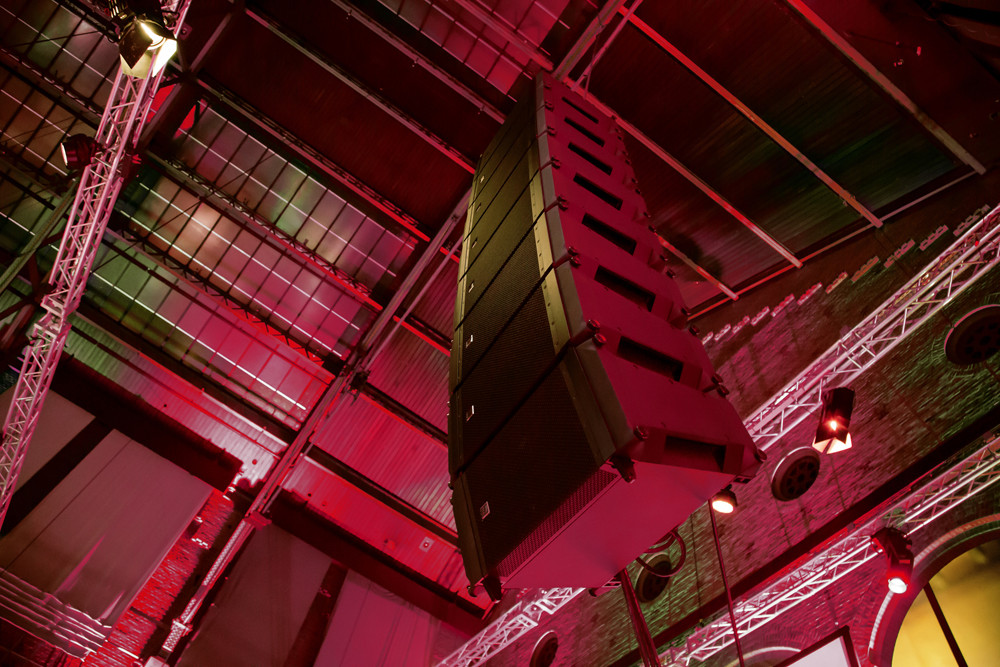
The company’s latest line array technology, embodied in the X-Line Advance Series.
Further new developments are forthcoming immediately, including the launch of the EVC Series of installation loudspeakers and the EVOLVE 50 compact column system. This steady stream of innovation says that although times have definitely changed over the course of the company’s nine decades – accelerating even more rapidly the past two decades or so when pro audio has gone from a handful of brands to hundreds – the company is well-positioned to enjoy a bright future.
Sure, things have indeed changed a lot in 90 years, but in some ways they’ve remained much the same as they were in the “Roaring 20s” when the company got its start. “I don’t think the basic way we do business has changed,” stated Jim Long. “You need to identify problems that need to be solved and provide solutions, and in the process, build very close relationships with the people who make decisions.”